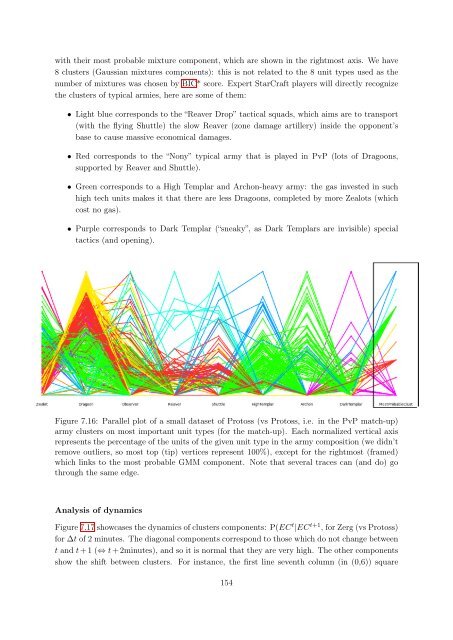Bayesian Programming and Learning for Multi-Player Video Games ...
Bayesian Programming and Learning for Multi-Player Video Games ...
Bayesian Programming and Learning for Multi-Player Video Games ...
Create successful ePaper yourself
Turn your PDF publications into a flip-book with our unique Google optimized e-Paper software.
with their most probable mixture component, which are shown in the rightmost axis. We have<br />
8 clusters (Gaussian mixtures components): this is not related to the 8 unit types used as the<br />
number of mixtures was chosen by BIC* score. Expert StarCraft players will directly recognize<br />
the clusters of typical armies, here are some of them:<br />
• Light blue corresponds to the “Reaver Drop” tactical squads, which aims are to transport<br />
(with the flying Shuttle) the slow Reaver (zone damage artillery) inside the opponent’s<br />
base to cause massive economical damages.<br />
• Red corresponds to the “Nony” typical army that is played in PvP (lots of Dragoons,<br />
supported by Reaver <strong>and</strong> Shuttle).<br />
• Green corresponds to a High Templar <strong>and</strong> Archon-heavy army: the gas invested in such<br />
high tech units makes it that there are less Dragoons, completed by more Zealots (which<br />
cost no gas).<br />
• Purple corresponds to Dark Templar (“sneaky”, as Dark Templars are invisible) special<br />
tactics (<strong>and</strong> opening).<br />
Figure 7.16: Parallel plot of a small dataset of Protoss (vs Protoss, i.e. in the PvP match-up)<br />
army clusters on most important unit types (<strong>for</strong> the match-up). Each normalized vertical axis<br />
represents the percentage of the units of the given unit type in the army composition (we didn’t<br />
remove outliers, so most top (tip) vertices represent 100%), except <strong>for</strong> the rightmost (framed)<br />
which links to the most probable GMM component. Note that several traces can (<strong>and</strong> do) go<br />
through the same edge.<br />
Analysis of dynamics<br />
Figure 7.17 showcases the dynamics of clusters components: P(EC t |EC t+1 , <strong>for</strong> Zerg (vs Protoss)<br />
<strong>for</strong> ∆t of 2 minutes. The diagonal components correspond to those which do not change between<br />
t <strong>and</strong> t + 1 (⇔ t + 2minutes), <strong>and</strong> so it is normal that they are very high. The other components<br />
show the shift between clusters. For instance, the first line seventh column (in (0,6)) square<br />
154


